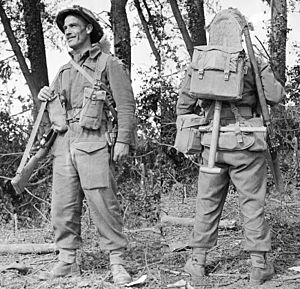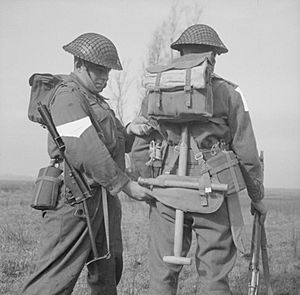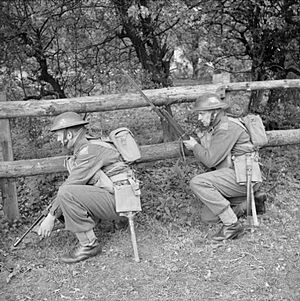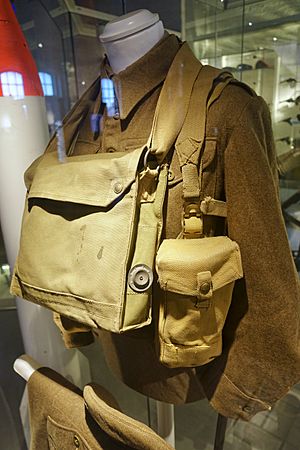1937 Pattern Web Equipment facts for kids
The 1937 Pattern Web Equipment, often called '37 Webbing', was a special set of gear used by soldiers to carry their supplies. It was like a backpack and belt system all in one! This equipment replaced older versions from 1908 and 1925. It became the standard gear for soldiers from the United Kingdom and other Commonwealth countries starting in 1937. Soldiers used it all through World War II and for many years after, until new gear called 58 pattern webbing came along. Some troops even used it until the mid-1980s!
Contents
Why Was This Equipment Made?
After the First World War, armies had a lot of old equipment. But as fighting changed, soldiers needed new, more flexible gear. In 1932, a group was formed to figure out how to make soldiers' uniforms and equipment better. They wanted a new design that could be changed easily to fit what each soldier needed for their specific job.
The company that made the older equipment, Mills Equipment Company, showed off four new designs. By 1934, one design was chosen. However, it took a few more years to decide on new weapons like the Bren gun. Once those decisions were made, the new webbing could finally be adopted.
The final design was approved on June 8, 1938, and soldiers started getting it in 1939. Later in World War II, some '37 Webbing was made in a "jungle green" color for troops fighting in hot, wet places like the Pacific Theatre. But soon, a special 44 Pattern Webbing was made just for the jungle. This new gear was lighter, dried faster, and didn't rot easily. Even though the 44 Pattern was great for jungles, the 37 Pattern stayed in use for most soldiers until the 58 Pattern was introduced.
What Did It Look Like?
The 1937 Pattern Webbing was made from strong cotton fabric. This fabric was waterproofed and dyed before it was woven. The metal parts were usually made of brass, but after the war, they were made of blackened steel. Many different companies made this equipment.
It usually came in a khaki color for the army. Soldiers could then dye it with a special compound called Blanco to make it different shades of green, or even blue-grey for the Royal Air Force. Military Police wore white webbing.
The basic parts of the equipment included:
- A belt (which came in "Normal" and "Large" sizes).
- Cross straps (called 'braces') that went over the shoulders.
- Pouches to carry ammunition, grenades, or other items.
- A carrier for a water bottle.
- A small pack (like a small backpack).
Some older items from World War I, like a large pack and a tool carrier, were also kept. There were also special holders for bayonets (knives that attach to rifles). Soldiers would arrange these parts in different ways for "marching order" (when carrying everything) or "battle order" (when ready to fight). Officers and tank crew members had special pouches for binoculars, pistol ammunition, and holsters for their pistols. A fully loaded set for an infantry soldier could weigh about 56 pounds!
Main Parts of the Equipment
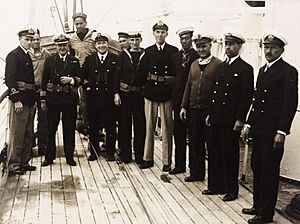
Basic Pieces
- Small Pack (Haversack): This was a rectangular bag worn on the left hip. It had sections inside for things like washing kits, a sewing kit, a spare shirt, socks, and a towel. It was worn on the back if the larger pack wasn't being used.
- Binoculars Case: A box for carrying binoculars. It attached to the belt. This same case could also hold a special sight for the BREN gun.
- Compass Pouch: A small square pouch, similar to a pistol ammunition pouch, but with soft padding inside to protect a compass. It was worn on the right shoulder strap.
- Mess Tin: A new type of mess tin was made for this equipment. It was a two-piece rectangular tin with folding handles for cooking and eating. Soldiers also used an enamel mug for drinks.
- Water Bottle: The water bottle itself was the same as older models, but the carrier for it was updated to fit the new webbing. It was usually worn on the right hip.
- Large Pack: A bigger rectangular pack worn on the back. It held a great coat (a heavy overcoat), spare clothes, and socks.
- Basic Pouches: Two pouches worn on the front of the belt. One held two magazines for the Bren gun, and the other held one spare Bren magazine and a bandolier (a strip of cloth with pockets for ammunition). These were held in place by the shoulder straps.
- Field Service Marching Order (FSMO): This was the full set of equipment an infantry soldier would carry. It included the Large Pack, Small Pack (on the left side), Bren Magazine Pouches, and the Water Bottle.
- Battle Order: This was a lighter setup for fighting. It included the Small Pack, two Basic Pouches, a bayonet frog (holder for the bayonet) on the left side, and the Water Bottle on the right side.
Holsters for Pistols
- Pistol Case: A holster worn on the left hip that held the Enfield No 2 Revolver.
- Pistol Case, Royal Armoured Corps: This holster was worn on the right thigh by tank commanders for their Enfield No 2 Revolver. It had a long strap to secure it to the leg and loops for extra ammunition.
- Pistol Case, Parachute Regiment: A thigh holster for the Colt 1911 ACP Automatic Pistol. It was longer than other holsters to fit the pistol's barrel.
Ammunition Carriers
The system was designed so soldiers could mix and match parts, but there were official ways to wear the gear.
- Grenade Carrier: A horizontal case with two pouches, each holding a No 36M Mills Bomb grenade. It slid onto the belt and was worn on the hip.
- Basic Pouch: A large vertical pouch that came in three versions. It could carry two BREN magazines, six Thompson SMG magazines, four grenades, or boxes of small arms ammunition. The Mark III version was longer and could hold five 32-round STEN Machine Carbine magazines.
- Pistol Ammunition Pouch: A small pouch for a box of 12 rounds of .38/200 ammunition for the Enfield No 2 Revolver.
- Cartridge Carrier: A horizontal case with two pouches, holding a total of 20 rifle rounds (four 5-round clips). It was for non-infantry soldiers who carried a rifle.
- Lanchester Magazine Pouch: A long rectangular pouch that held three 50-round magazines for the Lanchester Machine Carbine, used by the Royal Marines, Royal Navy, and RAF. It was quite tall when worn!
- Vickers G.O. Gun Magazine Pouch: An oval pouch designed to hold a 100-round drum for the Vickers K machine gun.
Other Accessories
- Bandolier: A rectangular piece of cloth with five pockets and a shoulder strap, used to carry extra ammunition.
- Utility Pouch: A pair of large vertical pouches with a built-in yoke (a part that goes over the neck) and a strap to secure them across the chest. It was a bigger version of the Basic Pouch. Each pouch could hold three BREN gun magazines, two Boys Anti-Tank Rifle magazines, mortar shells, a water bottle, grenades, or ammunition boxes.
- Anti-gas Respirator Haversack: A large bag to hold the gas mask. It was designed to be worn high on the chest or slung over the shoulder. Later versions were simplified to use less metal.
See also


